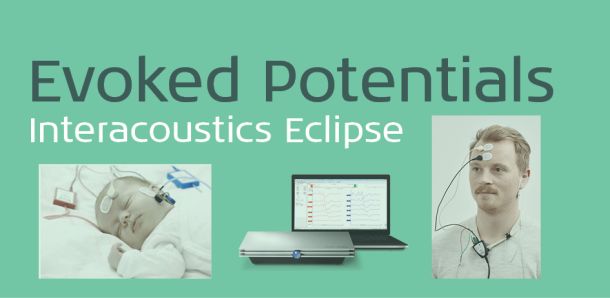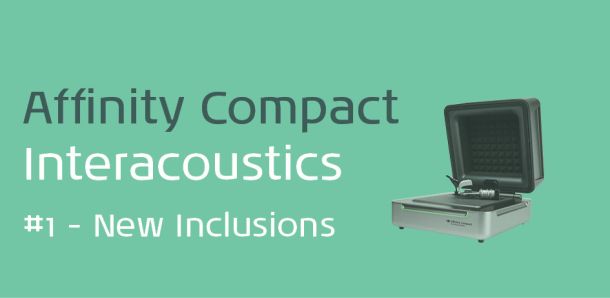Tips and Tricks for obtaining the best ECochG results on the Interacoustics Eclipse
Electrocochleography, or ECochG, testing can be a valuable tool in the vestibular test battery.
If you are new to ECochG testing or would like a refresher, webinars are available on our website as an introduction to ECochG testing. Please find the links here to get you started:
Electrode types and configuration
ECochG’s may be recorded using 3 different electrode types:
Transtympanic – this method uses a needle electrode through the eardrum. This results in the most robust response compared to other electrode types, however, in view that it requires a doctor to perform the test, it is not feasible for most clinics. Interacoustics do no provide this option for our clinics.
TM-trode – placed on the eardrum.
The preparation of this electrode involves the following:


Place 2 cc of saline in the ear canal for 10 minutes, be careful of the temperature so that you do not induce a caloric response. Keep as close to body temp as possible (37 deg).
Drain ear of saline and place TM-trode on the eardrum. You will see the ongoing EEG activity reduce as you get closer to the eardrum placement. Use medical tape to hold end of TM-trode in place. You may not achieve below 25kOhms in impedance, it is fine to continue testing if you have low EEG activity.
Electrode configuration for TM-trode :-

You can place the jumper cable in either ground or vertex. You may see configurations with either of these options. See what works best for your patient.
Gold Tip trode
The ear canals need to be cleaned using Nuprep abrasive gel. Only clean the outer section where the tip trodes will sit in the ear canal. Attach the gold tip trode using the clamp on the electrode cable, making sure the clamp is touching the gold foil. The gold tip trode needs to have conductive paste applied around the exterior portion, without blocking the sound bore.


This is the tip trode electrode configuration:

Alternative configuration option: Instead of both gold electrodes in the ears, you can also use an electrode on the mastoid of the non-test ear. However, you need to remember to swap this over when testing the other ear. This can be helpful if there is an issue with getting impedance levels down. The impedances for tip trode should be < 5kOhms.
Other things to consider in ECochG testing
- Ensure that ECochG leads are separate to transducer leads.
- Turn off everything that is electrical in the room – lights, mobiles, equipment not being used.
- Make sure the pre-amp is also away from the patient
In general, the Eclipse ECochG protocol should not need to be changed. However, if there are issues with surrounding noise during testing, you can change the filter settings.
For reducing noise:
Try the highpass filter on 10 Hz or 30 Hz depending on the surrounding noise, and the low pass filter on 3000hz. Always test in alternating mode. If Bayesian weighting is not on, it is recommend turning this on as well.
Once ready to test:-
- Select EcochG Click protocol from the drop-down menu on the main screen
- Select which ear you would like to test
- Select level, 90dB or 95dB if there is a hearing loss.
- Press start
- Monitor the EEG to keep noise levels low during testing.
- For tip trode and TM-trode need 1000-1500 recordings for signal averaging, a lot less is needed with transtympanic needle.
Once you have your waveform, you can then mark using one of two different methods. The older method is amplitude ratio. This method does not consider the widening of the SP component with Menieres. The newer method of calculation - area ratio, is more sensitive, around 90% sensitivity (Al-momani, Ferraro et al 2009)
Below is an example of both types of calculations.
For amplitude ratio only need BL, SP and AP to calculate

For amplitude ratio – these are the cut offs for normal range

Area Ratio
Markings needed for area ratio

Pathology

Devaiah, Dawson, Ferraro, Ator (2009)
To chat to our team about your eCochG testing and results and how we can help you better refine your assessments, please call (02) 8899 1200 or email us at
References:
- Al-Momani M, Ferraro J, Ator G, Gajewski B (2009) Improved Sensitivity of ECochG in the diagnosis of Meniere’s disease. International Journal of Audiology, 48 : 811-819
- Devaiah, A.K., Dawson, K.L., Ferraro, J.A., & Ator, G.A. (2009). Utility of area curve ratio electrocochleography in early Meniere's disease. Arch Otolaryngol Head Neck Surg, 129, 547-551.
- Hall, J. & Mueller, G. (1997) Audiologists' Desk Reference: Diagnostic audiology principles, procedures, and protocols. Singular Publishing Group.
Latest Articles

ABR Interacoustics Eclipse

ASSR and ABR Comparison on the Eclipse
